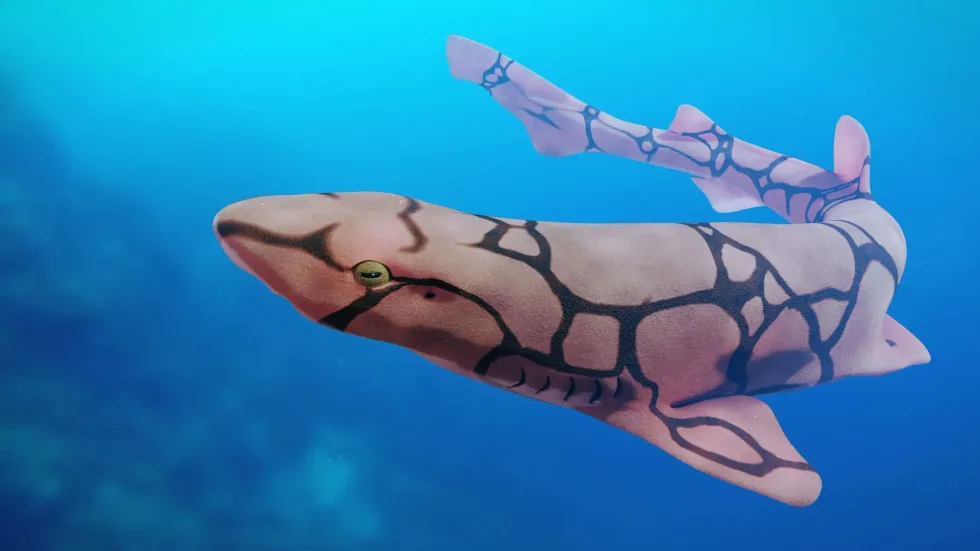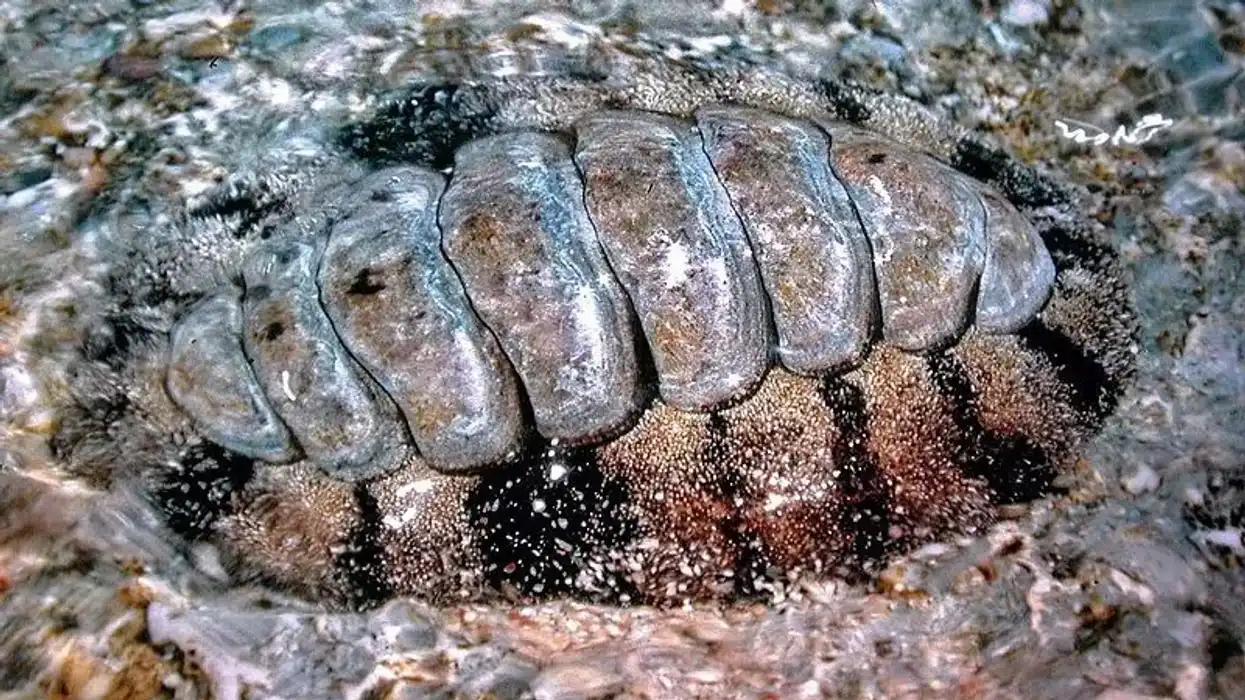Scientifically called Scyliorhinus retifer, this species comes from the Scliorhinidae family and belongs to the Scyliorhinus genus. Also known as the chain dogfish, this fish is harmless and is a pretty sight in an aquarium.
This catshark is common to the northwest Atlantic, the western Atlantic, the Gulf of Mexico, and the Caribbean. Through research, it has also been found that the chain dogfish does not perform any long-distanced migration.
Their preferred water temperature is the reason why these sharks are restricted to their range.
They are slender and small with a shark-like appearance. The eyes of chain dogfish are oval and these fishes have a rounded blunt snout.
The second dorsal fin is about half the size of the first dorsal. This shark is said to go as deep as 118-755 ft (35.9-230.1 m) in the northern part of its range and in the southern areas, 1,510 ft (460.2 m)!
Found in waters ranging from cold to cool temperatures, the preferred habit of this species is interesting. These shy and nocturnal sharks are often found spending their day resting in crevices and prefer rough, rocky bottoms.
Chain catsharks prefer rocky and rough bottoms as that is where they are often located, coming into contact with other water creatures and structures. As a result, young sharks are often captured and placed in an aquarium instead of the adult shark since they easily camouflage with the sandy bottoms.
Reproductive biology has observed that the reproduction process in these species is oviparous. This means that the eggs or embryos develop outside the mother's body.
Some common predators of the chain catshark are large piscivorous fishes and sharks. The unique pattern on their bodies makes them great aquarium displays!
If you'd like to learn more about sharks, check out our facts about the Caribbean reef shark or great white shark.
Chain Catshark Interesting Facts
What type of animal is a chain catshark?
The chain catshark or the chain dogfish is a small size shark that is found in various parts of the Atlantic Ocean. This shark species is inactive and often spends its day resting. It's only at night that these sharks move around after feeding on small fishes, squids, small shrimps, and bristle worms.
What class of animal does a chain catshark belong to?
The chain catshark is a shark and comes under the class of fish. They belong to the genus Scyliorhinus and the Carcharhiniformes order.
How many chain catsharks are there in the world?
The number of chain catsharks around the world has not been quantified as yet. However, given their Least Concern conservation status, the distribution of this shark species is stable as they are not caught for consumption but rather for display purposes in aquariums.
Where does a chain catshark live?
This bottom-dwelling chain dogfish occurs in the northwest and western Atlantic, the Gulf of Mexico, and parts of western Caribbean. Their habitat is the outer continental shelf and upper slope on rough sandy bottoms.
What is a chain catshark' habitat?
The habitat of this shark is found in the deep parts of the ocean and lies motionless during the day on rocky or rough bottoms. Being nocturnal, it is only at night that these sharks move around energetically.
Who does chain catshark live with?
This chain dogfish species does not live with any other fish and are solitary, spending their day resting on the rocky seabed.
How long does a chain catshark live?
As they are part of the catshark species, they live for a period of about 12-13 years. To estimate the age of a chain dogfish, scientists and researchers often count the rings on their vertebrates, similar to counting the rings on the trunk of a tree to estimate its years!
How do they reproduce?
The Scyliorhinus retifer species has a very elaborate reproduction process. The females are polygynandrous, meaning that they mate with several males.
Mating generally occurs in places where there are structures such as gorgonians or manmade structures. The female uses these to deposit the embryos. From their observed behavior, the mature male shark bites the female until it gets a firm hold on her and then proceeds to wrap its body around the female for mating.
Chain catsharks are oviparous. This means that the embryo or egg develops outside the mother. Each pregnant female releases two box-shaped egg cases after an unknown gestation period. After about 250 days, the embryos emerge from their egg case and take 8-12 months to develop due to temperature variations in the environment.
The young hatch from their egg cases after 7-12 months. The eggs are laid in pairs, and approximately 44-52 eggs are laid per year. These egg cases are also often referred to as a 'mermaid's purse'.
What is their conservation status?
The conservation status of these catsharks is Least Concern by the IUCN and their distribution is quite stable in its range. Known to be fished for display purposes only, these sharks are not consumed by humans.
Chain Catshark Fun Facts
What does the chain catshark look like?
A Scyliorhinus retifer has a slender body with a blunt snout narrowing to a slender tail. There is a space between the second dorsal fin and the caudal fins. The first dorsal fin sits slightly behind the level of the base of the pectoral fins.
Chain catsharks have smooth skin that is tannish brown, often with a hint of yellow and with brownish-black chainlike markings on the body and dorsal fin, giving them their common name. The skin is embedded with small denticles. They have yellowish-green eyes.
How cute are they?
More than cute, these small size sharks are super attractive! They are considered harmless to humans, and because of their coloring and significant snake-like skin, they are often placed in an aquarium and people enjoy looking at them for their shark-like appearance.
How do they communicate?
There is no data available describing the communication and perception of Scyliorhinus retifer. However, like other shark species, these catsharks are likely to have sensitive tactile and chemoreception that they use extensively in foraging.
How big is a chain catshark?
Chain catshark size is similar to the size and features of a small-spotted catshark that is around 23.2 in (59 cm) in length.
How fast can a chain catshark swim?
Catsharks are not the fastest sharks by any means and the fishes in this shark species are lazy swimmers. With their distribution found along the upper slope of the Mid-Atlantic Bight, the females are often swimming with the males in pairs during the breeding season.
The juveniles are seen to be slightly more active in behavior than the adults which makes them easier to capture compared to the adults who lie right at the bottom.
How much does a chain catshark weigh?
The chain dogfish is estimated to weigh about 10.5-13.4 oz (297.6-379.8 g), the same as an Andean bear cub!
What are the male and female names of the species?
There are no specific male and female names for this species. They are commonly called chain catsharks or chain dogfishes. Scientifically, they go by the name Scyliorhinus retifer.
What would you call a baby chain catshark?
You'd be surprised to learn that the young one of this species is called a chain catshark pup! The egg is laid by the female in the blastodisc form.
What do they eat?
The chain catshark diet includes feeding on squid, bony fish, crustaceans, and bristle worms. Recently discovered, there has been a shift in the diet of these sharks, with mature adults consuming more fish and invertebrates than juveniles.
Are they dangerous?
Charin dogfish are harmless to humans and do not pose any threat.
Would they make a good pet?
Yes, they are good pets and add a touch of color to your aquarium, given their unique pattern and small size! Great care must be taken if you decide to keep them as pets.
Maintaining the water temperature is very important for these fishes.
A 120 gal (454.2 L) aquarium is sufficient to house one chain catshark and a chiller must be placed inside to maintain the temperature requirement as that of their natural habitat. Apart from being kept in an aquarium, these sharks are frequently kept in laboratories for research purposes.
Did you know...
Apart from their striking pattern, the shark’s skin glows making them quite a spectacle at night. Chain catsharks can transform the ocean’s blue light into a luminous green hue.
This phenomenon, called biofluorescence, has been studied in other marine creatures that are known to convert light through the action of a protein. However, it is not known whether or not this phenomenon happens in an aquarium.
How did chain catsharks get its name?
Belonging to the family of sharks known as Scyliorhinidae, they are called catsharks because of their elongated cat-like eyes and sharp teeth.
Are chain catsharks dangerous?
No, they are not dangerous! You would think that they are as they belong to the shark family but the behavior of this particular species is sluggish and does not pose any threat to humans.
Here at Kidadl, we have carefully created lots of interesting family-friendly animal facts for everyone to discover! For more relatable content, check out these bull shark facts and tiger shark facts for kids.
You can even occupy yourself at home by coloring in one of our free printable chain catshark coloring pages.
Second image by Cliff from Arlington, Virgina, USA










